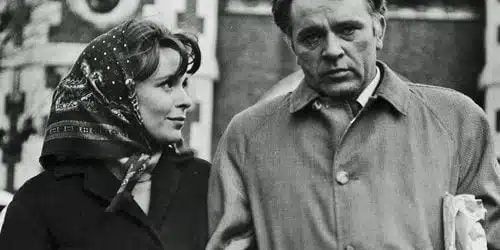
Novels written by David John Moore Cornwell, better known by his pen name John le Carré, have provided material for two of the most cynical espionage movies of all time. The 2011 adaptation of Tinker Tailor Soldier Spy was rightfully acclaimed for its consistently bleak view of British intelligence operations, but that film was preceded by an even greater achievement, the 1965 Martin Ritt adaptation of The Spy Who Came in from the Cold.
The tone of The Spy Who Came in from the Cold is established in the credits sequence, which opens with a static shot of barbed wire atop a concrete wall. The camera pulls back to reveal rain-soaked pavement and an armed guard in the distance, then pulls back further and cranes left to reveal that the location is Check Point Charlie, the Allied crossing point between East and West Berlin. Inside the guard station, the director of the “Circus” (British Intelligence) in Berlin, Alec Leamas (Richard Burton, who received an Academy Award nomination for his performance), is first seen from the back, as a young assistant brings him coffee and urges him to go home and get some rest.
Leamas is beyond weary, and not just because of the late hour, or the immediate tension as he waits for one of his operatives to make the treacherous crossing back from East to West Berlin. He’s burned out by the work and, as we later learn, by his lack of attachment to any person or ideal. Despite an expression of concern to his subordinate, Leamas scarcely reacts as the operative is gunned down a few feet from freedom, a failed operation that results in Leamas’ quick dispatch back to London.
He’s ready to pack it in, but his boss Control (Cyril Cusack) has one more mission in mind before Leamas is allowed to “come in from the cold” (retire). This mission involves setting up Leamas to be recruited by the East Germans as a traitor, so he can plant information to discredit a high-ranking East German intelligence officer, Hans-Dieter Mundt (Peter van Eyck).
As part of the cover for this mission, Leamas takes a job in the library of the “Blantyre Institute of Psychical Research”, where he soon begins an affair with a young co-worker, Nan Perry (a vibrant Claire Bloom). Nan is perhaps the only non-cynical person in this film: she loves Leamas without reservation, and she’s also serious about her work with the Communist Party, which she believes will be able to bring about world peace. Such openness to feeling, and to ideals, leaves her vulnerable to the machinations of those who have learned to temper (or do without) both.
The Spy Who Came in from the Cold is a richly rewarding film, but to enjoy it you have to be willing to tolerate long periods during which you may not be sure what is going on, as well as a twisty plot that delivers no clear lessons or moral uplift. On the plus side, it bears up well to repeated viewings.
Paul Dehn and Guy Trosper’s script is full of wonderful dialogue that underlines le Carré’s dim view of the espionage trade, beginning with Control’s guiding philosophy, as stated to Leamas: “Our policies are peaceful, but our methods can’t afford to be less ruthless than those of the opposition, can they?” Leamas later describes spies to Nan as “just a bunch of seedy, squalid bastards like me. Little men. Drunkards, queers, henpecked husbands, civil servants, playing cowboys and Indians to brighten their rotten little lives.”
Fiedler (Oskar Werner), an East German interrogator, tells Leamas that he’s “A wanted, spent, dishonest man. The lowest currency of the cold war” and that if he were to shoot Leamas on the spot “Not a bird would stir in the trees outside. Not a single peasant would turn his head to see what fell.”
Oswald Morris’ black and white cinematography is as crucial to the film as the script or the actors’ performances, creating a consistently dreary, chilly mood to match Le Carre’s cynical outlook. Morris, whose other credits include Stanley Kubrick’s Lolita and John Huston’s Moby Dick, was at the top of his form in this film, and it’s essential viewing for anyone interested in cinematography.
The Oscar-nominated set decoration/art decoration (credited to Hal Pereira, Tambi Larsen, Ted Marshall, and Josie MacAvin) includes some delightful surprises, including a scene set in a strip club (appropriate for a film so cynical about both love and morals) and a courtroom festooned with antlers. The film looks wonderful in this restoration from a 35mm positive, with essentially no flaws or artifacts evident, and the sound is also excellent.
The Criterion Collection release comes with a generous package of extras although, unfortunately, no commentary track. As a consolation prize, there is a 40-minute clip selection with commentary by Morris (he calls the opening sequence “the best and most apt of any of the 58 feature films I photographed,” because it so well established the mood of the movie to come).
Two supplements focus on author John Le Carré: a 39-minute interview and a 59-minute BBC documentary from 2000 that focuses on Le Carré’s life (which has quite a few twists and turns of its own) and work. There’s also a 49-minute audio interview of director Martin Ritt by film historian Patrick McGilligan, a gallery of set designs, the film’s theatrical trailer, and a 20-page illustrated booklet featuring an essay by film critic Michael Sgragow.

